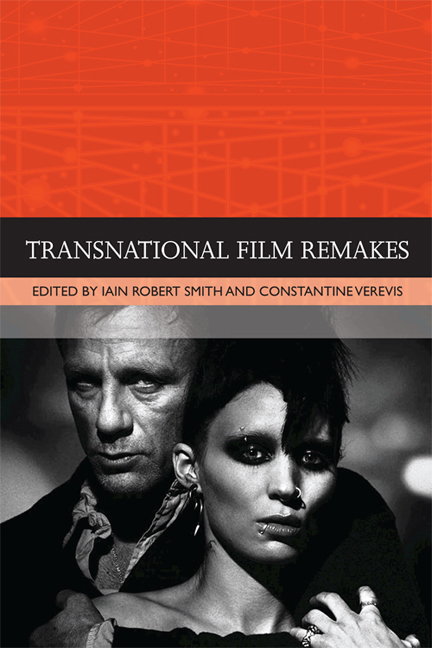Book contents
- Frontmatter
- Contents
- List of Illustrations
- Traditions in World Cinema
- Introduction: Transnational Film Remakes
- PART I GENRES AND TRADITIONS
- 1 Disrupting the Remake: The Girl with the Dragon Tattoo
- 2 Fritz Lang Remakes Jean Renoir for Hollywood: Film Noir in Three National Voices
- 3 The Cultural Politics of Remaking Spanish Horror Films in the Twenty-first Century: Quarantine and Come Out and Play
- 4 ‘For the Dead Travel Fast’: The Transnational Afterlives of Dracula
- PART II GENDER AND PERFORMANCE
- PART III AUTEURS AND CRITICS
- Notes on the Contributors
- Index
2 - Fritz Lang Remakes Jean Renoir for Hollywood: Film Noir in Three National Voices
from PART I - GENRES AND TRADITIONS
Published online by Cambridge University Press: 22 December 2017
- Frontmatter
- Contents
- List of Illustrations
- Traditions in World Cinema
- Introduction: Transnational Film Remakes
- PART I GENRES AND TRADITIONS
- 1 Disrupting the Remake: The Girl with the Dragon Tattoo
- 2 Fritz Lang Remakes Jean Renoir for Hollywood: Film Noir in Three National Voices
- 3 The Cultural Politics of Remaking Spanish Horror Films in the Twenty-first Century: Quarantine and Come Out and Play
- 4 ‘For the Dead Travel Fast’: The Transnational Afterlives of Dracula
- PART II GENDER AND PERFORMANCE
- PART III AUTEURS AND CRITICS
- Notes on the Contributors
- Index
Summary
A commonplace of criticism devoted to the classic American film noir (c.1941– 58) has been that this post-war series is essentially a transnational phenomenon, with its style, themes, and characteristic narrative patterns emerging from a complex interplay among several native and European traditions, both literary and cinematic (see Schrader 1972: 8–10 and Palmer 2016: chs 4–5). Acknowledged as the most significant of these are Weimar Expressionism and the Neue Sachlichkeit; French poetic realism and Surrealism; American postwar semi-documentarianism; and the different genres of popular literature that are usually, not without distortion, bundled together under the rubric of hardboiled fiction, whose principal authors, including James M. Cain, Raymond Chandler, Dashiell Hammett and Cornell Woolrich, were associated directly or indirectly with Black Mask magazine, constituting something like an informal school (see Nolan 1987: Introduction).
Already amply demonstrated by scholars, of course, is that even more complex forms of transnationalism define post-classic noir, as well as its ‘branches’ in many other national cinemas; this filmic development, like classic noir itself, has a literary reflex, evidenced in the worldwide popularity of the English-language roman noir (successor to the hard-boiled tradition) and its imitations in other cultures such as Nordic Noir (for global noir, see Pettey and Palmer 2014; for Nordic Noir, both cinematic and literary, see Nestingen 2008). Understandably partial to explanations that emphasise strictly filmic developments, historians of classic noir have often tended to underestimate the importance of ‘dark fiction’ of various kinds and national origins for the development of the series, a blindness to which this essay offers a partial corrective.
In the aesthetic mixing that resulted in the emergence of classic noir, three national voices made for an interesting harmony that, as we shall see, cannot be reduced to a simple division between visual style/art design, where the French and German high art movements make their influence felt in motif and technique, and themes drawn from American popular culture that provide these films with character, setting, and narrative. Hollywood's absorption of noirish releases from 1930s French cinema speaks to the transauthorial creation of noirness as a repertoire of themes, characters, and narrative patterns upon which subsequent productions in the series continued to draw. Indicating a resonance across different cultures and artistic traditions, this deep transnationalism interestingly forecasts the emergence of noir traditions in other industries as the series went global in the second half of the twentieth century.
- Type
- Chapter
- Information
- Transnational Film Remakes , pp. 36 - 53Publisher: Edinburgh University PressPrint publication year: 2017

